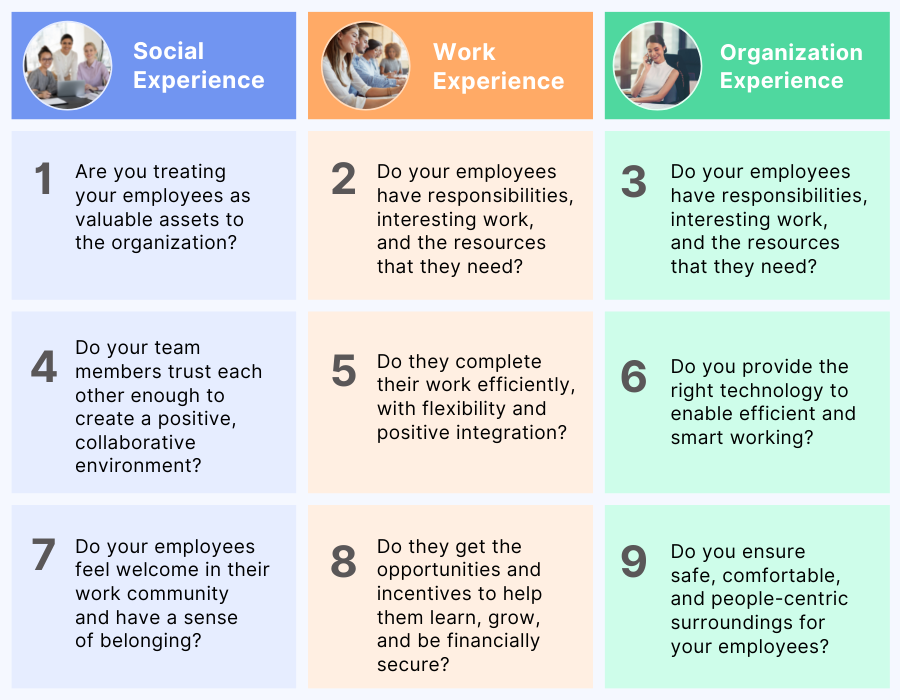Was ist Employee Experience und die verschiedenen Phasen, die sie umfasst
Bevor Sie erfahren, was ein Mitarbeitererlebnis ist und wie die verschiedenen Phasen des Mitarbeitererlebnisses im Detail aussehen, sollten Sie den Begriff in einfachen Worten verstehen. Das Mitarbeitererlebnis ist die Reise, die ein Mitarbeiter mit einem Unternehmen unternimmt, angefangen von der Einstellung über die Einstellung bis hin zu den Interaktionen, die er beim Verlassen des Unternehmens hat.
Auf dieser Seite
- Was ist Mitarbeitererfahrung?
- Vom Engagement zum Erlebnis
- Arten von Mitarbeitererfahrungen
- 5 Etappen der Mitarbeitererfahrung
- Mitarbeitererfahrung als KPI
- Die Checkliste für Mitarbeitererfahrungen
- Beispiele für Unternehmen mit hervorragenden Mitarbeitererfahrungen
- Der Einfluss von Mitarbeitererfahrungen
- Mitarbeitererfahrung durch Engagement verändern
- Auf dem Weg zu einer mitarbeiterorientierten Zukunft
In den letzten Jahren hat ein unbeständiges wirtschaftliches Umfeld mit Massenkündigungen die Unternehmen dazu gezwungen, ihre Prioritäten in Bezug auf ihre Mitarbeiter neu zu ordnen. Dies hat sicherlich das Thema Mitarbeiterengagement und -zufriedenheit in den Vordergrund gerückt, allerdings mit einem neuen Schwerpunkt auf Erfahrung.
Als Michelle und Max, zwei Accenture-Mitarbeiter, unter ihren Kollegen eine Spendenaktion für das neue Bürgerrechtsprogramm über die MyGiving-Plattform von Accenture starteten, wurde sie vom Corporate-Citizenship-Team des Unternehmens in den USA aufgegriffen.
Accenture verdoppelte die Spenden seiner Mitarbeiter in Höhe von 20.000 Dollar und bewies damit sein Engagement für seine Mitarbeiter, deren Anliegen und Gemeinden.
Ein anonymer Mitarbeiter der Bank of America schrieb:
"Die Art und Weise, wie das Managementteam, die leitenden Angestellten und das Führungsteam auf die Pandemie und die systemischen Rassismusprobleme in diesem Jahr reagiert haben, hat mir gezeigt, wie großartig unser Unternehmen ist und wie sehr unseren Führungskräften unsere Mitarbeiter wirklich am Herzen liegen. Besonders stolz war ich auf unsere 1-Milliarde-Dollar-Initiative zur Bekämpfung des systemischen Rassismus zu einer Zeit, als andere Unternehmen nur Plattitüden von sich gaben, schwiegen oder kleinere Maßnahmen ergriffen."
Der rote Faden, der sich durch diese beiden Erzählungen zieht, ist die "Erfahrung" - eine Erfahrung, die diese Mitarbeiter in ihren jeweiligen Unternehmen gemacht haben, und der starke Eindruck, den diese bei ihnen hinterlassen hat. Die Mitarbeitererfahrung hat sich von einem "Gimmick" zu einem "geschäftlichen Muss" entwickelt.
Von der Personalabteilung über die IT-Abteilung bis hin zum CEO konzentrieren sich alle darauf, ihre Unternehmenskultur durch die Schaffung authentischer Erlebnisse für ihre Mitarbeiter umzugestalten.
Bevor wir uns damit befassen, was Mitarbeitererfahrungen sind und wie sie einen transformativen organisatorischen Wandel vorantreiben.
Was ist Mitarbeitererfahrung?
Die Mitarbeitererfahrung ist die Reise, die ein Mitarbeiter mit einer Organisation unternimmt. Sie umfasst jede Interaktion, die entlang des Lebenszyklus eines Mitarbeiters stattfindet. (Quelle: Gallup)
Von dem Zeitpunkt an, an dem sich ein potenzieller Kandidat für eine Stelle in Ihrem Unternehmen bewirbt, bis zu dem Zeitpunkt, an dem er Ihr Unternehmen wieder verlässt, macht die Summe aller Interaktionen, die er macht, die Gesamtheit seiner Erfahrung aus.
Schauen wir uns das mal genauer an.
Erfahrung gibt den Mitarbeitern ein gutes Gefühl bei der Arbeit in ihrem Unternehmen:
- Gibt ihnen das Gefühl, wertgeschätzt zu werden (Sinnhaftigkeit)
- ein Gefühl der Zugehörigkeit zu schaffen und
- Fördert das Engagement
Arbeitnehmer, die keine guten Erfahrungen machen, denken nicht zweimal darüber nach zu kündigen.
Vom Engagement zum Erlebnis
Vor nicht allzu langer Zeit war der Begriff "Employee Experience" noch relativ neu, und die Unternehmen konzentrierten sich noch auf die Verbesserung des Engagements, um die Produktivität zu steigern.
Studien zeigen, dass das alte Modell des Engagements zwar immer noch wichtig ist, aber nicht mehr der entscheidende Faktor für die Zufriedenheit und Produktivität der Mitarbeiter ist. Stattdessen ist das Mitarbeitererlebnis der neue KPI für Personalverantwortliche und Unternehmensleiter, um die Unternehmensleistung zu messen.
Um diesen Wechsel von den traditionellen Modellen des Engagements hin zum revolutionären Konzept des Mitarbeitererlebnisses nachvollziehen zu können, ist es notwendig, die Faktoren zu verstehen, die diesen Paradigmenwechsel vorantreiben. Sowohl das Mitarbeiterengagement als auch die Mitarbeitererfahrung wirken sich auf die Produktivität, den Umsatz und die Rentabilität des Unternehmens aus, aber es gibt einen Unterschied:
Mitarbeitererfahrung ist die Reise, die ein Mitarbeiter mit dem Unternehmen unternimmt, und das Engagement ist ein wesentlicher Bestandteil jeder Phase dieser Reise.
Früher war Engagement der Schlüssel zu hoher Leistung und Effizienz. Mit der Großen Resignation änderte sich dies alles. Plötzlich kündigten die Menschen in Scharen, weil sie unzufrieden waren und sich unterbewertet fühlten. Die Mitarbeiter stehen im Mittelpunkt und es stellt sich die Frage: Wie kann man sie bei Laune halten und die Massenabwanderung stoppen?
Die Antwort liegt in der Schaffung einer neuen Art von integrativem Arbeitsplatz, an dem die Mitarbeiter mit positiven Erfahrungen beschäftigt sind, um ein Höchstmaß an Produktivität zu erreichen.
Einige der Faktoren, die diese Verschiebung bewirken, sind:
- Sich ändernde Erwartungen: Die moderne Belegschaft unterscheidet sich von den früheren Generationen und erwartet, dass sie so behandelt wird, wie das Unternehmen seine Kunden behandelt. Es geht nicht in erster Linie um Geld oder Arbeitszufriedenheit, sondern um personalisierte und positive Erfahrungen während ihrer Reise mit dem Unternehmen.
- Wirtschaftliche Digitalisierung und Disruption: Das beschleunigte Tempo der Digitalisierung und der wirtschaftlichen Disruption hat zu einem massiven Wandel in den Unternehmen geführt, der sie dazu zwingt, als Reaktion auf die Markttrends nach oben oder unten zu skalieren. Dies wiederum hat Auswirkungen auf die Mitarbeiter hinsichtlich ihrer allgemeinen Erfahrungen in den Unternehmen.
- Mehrgenerationen-Belegschaft: Angesichts der Vielfalt am Arbeitsplatz mussten die Unternehmen ein tieferes Verständnis für die sozialen, psychologischen und verhaltensbezogenen Unterschiede zwischen Millennials und der Generation Z entwickeln, um die richtigen Erfahrungen zu machen.
- Der Krieg um Talente: Da es mehr Stellen als Bewerber auf dem Markt gibt, kann der Ausgang des Kampfes um Talente nur auf eine Weise bestimmt werden: durch Erfahrung. Unternehmen, die ihren Mitarbeitern die besten Erfahrungen bieten, werden in der Lage sein, die besten Talente der Branche anzuziehen und zu halten.
- Das Aufkommen der sozialen Medien: Mit dem Aufkommen der sozialen Medien hat sich das Spielfeld für die Mitarbeiter geebnet. Um der Bedrohung durch negative Bewertungen entgegenzuwirken und ihren Ruf zu schützen, bemühen sich die Unternehmen darum, ihren Mitarbeitern gute Erfahrungen zu bieten.
Arten von Mitarbeitererfahrungen
Employee Experience (EX) umfasst jede Interaktion, die ein Mitarbeiter mit einem Unternehmen hat, von der Einstellung bis zum Ausscheiden. Hier sind die wichtigsten Arten von Mitarbeitererfahrungen, die die Zufriedenheit und das Engagement am Arbeitsplatz beeinflussen:
1. Kulturelle Erfahrungen der Mitarbeiter
Die Kultur ist das Rückgrat eines jeden Arbeitsplatzes. Sie umfasst die Werte eines Unternehmens, den Führungsstil, die Vielfalt, die Inklusivität und das allgemeine Arbeitsumfeld. Mitarbeiter, die mit der Unternehmenskultur übereinstimmen, haben ein stärkeres Gefühl der Zielsetzung und Zugehörigkeit.
Eine positive Kultur fördert das Vertrauen, die Zusammenarbeit und die Arbeitszufriedenheit. Eine toxische Kultur hingegen kann zu Unzufriedenheit, höherer Fluktuation und schlechter Leistung führen. Unternehmen, die sich auf den Aufbau einer starken, menschenzentrierten Kultur konzentrieren, schaffen ein Umfeld, in dem sich die Mitarbeiter geschätzt und respektiert fühlen und motiviert sind, ihren Beitrag zu leisten.
2. Technologische Erfahrungen der Mitarbeiter
Die Technologie spielt eine entscheidende Rolle für die Zufriedenheit und Effizienz der Mitarbeiter. Von Kommunikationstools bis hin zu Projektmanagement-Software - die Einfachheit des Zugriffs auf und der Nutzung von Technologie beeinflusst die täglichen Arbeitsabläufe. Veraltete Systeme, langsame Plattformen oder ein Mangel an digitaler Integration können zu Frustration führen und die Produktivität verringern.
Umgekehrt verbessert ein nahtloses, gut integriertes digitales Ökosystem die Zusammenarbeit, erhöht die Effizienz und minimiert den Stress am Arbeitsplatz. Unternehmen, die in moderne Arbeitsplatztechnologien investieren - wie KI-gesteuerte HR-Systeme, Cloud-basierte Tools für die Zusammenarbeit und automatisierte Arbeitsabläufe - stellen sicher, dass die Mitarbeiter ihre Aufgaben mit minimalen Reibungsverlusten erledigen können.
3. Physische Erfahrung der Mitarbeiter
Der physische Arbeitsplatz hat einen direkten Einfluss auf das Wohlbefinden, die Produktivität und das Engagement der Mitarbeiter. Unabhängig davon, ob sie in einem Büro, per Fernzugriff oder in einem gemischten System arbeiten, benötigen die Mitarbeiter eine Umgebung, die ihre Bedürfnisse unterstützt. Faktoren wie Büroraumgestaltung, ergonomische Möbel, natürliche Beleuchtung, Geräuschpegel und Wellnessbereiche beeinflussen den allgemeinen Komfort und die Arbeitszufriedenheit.
Unternehmen, die flexible Arbeitsregelungen, Stehpulte, Ruhezonen und Wellness-Räume anbieten, zeigen damit ihr Engagement für die Gesundheit und das Wohlbefinden ihrer Mitarbeiter. Ein gut gestalteter Arbeitsplatz fördert die Kreativität, reduziert den Stress und sorgt für ein positives Arbeitsklima.
4. Emotionales Mitarbeitererlebnis
Wie die Mitarbeiter ihre Arbeit, die Führung und die Interaktionen am Arbeitsplatz insgesamt empfinden, bestimmt ihr Engagement und ihre Einsatzbereitschaft. Eine starke emotionale Erfahrung beruht auf Vertrauen, Anerkennung, psychologischer Sicherheit und bedeutungsvollen Beziehungen.
Mitarbeiter, die sich wertgeschätzt und gehört fühlen, bleiben eher motiviert und engagieren sich in ihrer Rolle. Unternehmen, die Wert auf offene Kommunikation, regelmäßiges Feedback und Anerkennungsprogramme für Mitarbeiter legen, fördern ein Gefühl der Zugehörigkeit und Loyalität. Andererseits kann ein Mangel an emotionaler Unterstützung oder Stress am Arbeitsplatz zu Burnout, Desengagement und einer höheren Fluktuationsrate führen.
5 Etappen der Mitarbeitererfahrung
Die Mitarbeitererfahrung "erstreckt sich auf alle Unternehmensfunktionen und berührt alle Themen". - John Bersin
Die Mitarbeitererfahrung umfasst die sozialen, verhaltensbezogenen und psychologischen Aspekte des Lebenszyklus eines Mitarbeiters und erstreckt sich auf die folgenden Phasen:

1. Einstellung
Es beginnt damit, dass ein Bewerber auf die Stellenanzeige Ihres Unternehmens aufmerksam wird, und erstreckt sich über die gesamte Dauer des Einstellungsverfahrens bis zur Annahme des Angebotsschreibens.
Da sich die meisten Arbeitssuchenden auf Plattformen wie Glassdoor über das Unternehmen und die Arbeitskultur informieren, ist es wichtig, dass Sie Ihren bestehenden Mitarbeitern eine Erfahrung bieten, die zu guten Bewertungen und Empfehlungen führt.
Negative Erfahrungen sind gleichbedeutend mit negativen Bewertungen, die potenzielle neue Talente abschrecken könnten. Einige der wichtigsten Überlegungen in dieser Phase sind:
- Sind Ihre Stellenanzeigen eingängig genug, um die besten Talente auf dem Markt anzuziehen?
- Wie lange dauert der Einstellungsprozess?
- Ist Ihr Interviewprozess ansprechend und effizient?
- Wie hoch ist die Annahmequote?
- Wie bewertete der Bewerber die gesamte Erfahrung bei der Einstellung?
2. Einschulung
Die offizielle Annahme des Angebots signalisiert den Beginn des Lebenszyklus des Mitarbeiters. Neu eingestellte Mitarbeiter werden offiziell in die Unternehmenskultur eingeführt und mit der Arbeit, den Prozessen und den Technologien vertraut gemacht.
In dieser Phase ist es von entscheidender Bedeutung, Vertrauen zu schaffen und sicherzustellen, dass die neuen Mitarbeiter die Erwartungen an ihre neue Rolle voll erfüllen. Ein hervorragendes Onboarding-Erlebnis hilft neuen Mitarbeitern, sich schnell einzuarbeiten, produktiv zu werden und langfristig sinnvolle Beziehungen zur Marke aufzubauen. Es wäre hilfreich, wenn Sie die folgenden Punkte berücksichtigen würden:
- Stimmt Ihr Ziel mit dem Ihrer neuen Mitarbeiter überein?
- Wie lange ist die Anlaufzeit?
- Was tun Sie, um sie in die Unternehmenskultur zu integrieren?
- Sind sie in der Lage, in ihren Teams Vertrauen aufzubauen, zusammenzuarbeiten und innovativ zu sein?
3. Engagement
Die neuen Mitarbeiter haben sich eingewöhnt und arbeiten sich ein, aber was nun? Jetzt muss das Unternehmen die großen Geschütze auffahren: Engagement.
Engagement sorgt dafür, dass Ihre Mitarbeiter motiviert, leistungsfähig und hungrig nach mehr sind. Hier müssen Sie sicherstellen, dass Sie die besten Arbeitsbedingungen und -erfahrungen bieten und ihr Engagement kontinuierlich messen:
- Ist die Arbeit interessant und zielorientiert?
- Behandeln Sie ihre Beiträge als wertvoll?
- Verfügen sie über die richtigen Ressourcen und Technologien, um effizient zu arbeiten?
- Ist der Arbeitsplatz sicher, unterstützend und komfortabel?
- Sind sie in der Lage, flexibel und effizient zu arbeiten?
- Wie hoch ist die Engagement-Quote/Quote?
4. Leistung und Entwicklung
Dies ist ein kontinuierlicher Teil des Lebenszyklus eines Mitarbeiters während seiner gesamten Betriebszugehörigkeit. Jeder Mitarbeiter entwickelt sich in einem unterschiedlichen Tempo und mit unterschiedlichen Fähigkeiten. Hier muss das Unternehmen jedem Mitarbeiter helfen, sich zu entwickeln, zu wachsen, Karrierewünsche zu unterstützen, sich weiterzubilden, zu schulen und ihn durch positive soziale Erfahrungen zu befähigen, sein Bestes zu geben.
Eine starke Strategie zur Mitarbeiterbindung kann Mitarbeiter inspirieren, ihre Entwicklung auf Kurs halten und sie mit der Vision des Unternehmens in Einklang bringen. Dies ist der richtige Zeitpunkt, um in sich zu gehen:
- Bieten Sie die richtigen Anreize und Möglichkeiten zum Lernen, zur Fortbildung und zur Entwicklung?
- Haben Sie klare KPIs und KRAs zur Leistungsmessung festgelegt?
- Wie hoch ist die Produktivität?
- Haben Sie ein personalisiertes R&R-Programm zur Belohnung und Anerkennung Ihrer Mitarbeiter?
- Fühlen sich Ihre Mitarbeiter wertgeschätzt und haben sie ein Gefühl der Zugehörigkeit?
- Welche Strategie verfolgen Sie, um die Einstellungskosten zu senken?
5. Beenden Sie
Trotz des richtigen Engagements und der richtigen Erfahrungen werden sich einige Mitarbeiter aufgrund verschiedener Faktoren von ihrem Unternehmen trennen. Die Gründe können persönliche Umstände, Familie, Umzug, Ruhestand, berufliche Veränderungen usw. sein.
Aber nur weil ein Mitarbeiter sich entschlossen hat, das Unternehmen zu verlassen, darf das Unternehmen nicht bei seinen Erfahrungsinitiativen nachlassen. Dies ist die wichtigste Phase, da zufriedene Mitarbeiter die stärksten Fürsprecher der Marke sind und die besten Bewertungen über ihre Erfahrungen im Unternehmen abgeben.
Eine gute Austrittsbefragung kann dem Unternehmen helfen, Lücken und Verbesserungsmöglichkeiten für bestehende und künftige Mitarbeiter zu ermitteln, was die Fluktuation verringern kann. Einige Punkte sollten in dieser Phase beachtet werden:
- Haben Sie eine gute Ausstiegsbefragung/ein gutes Interview eingerichtet?
- Welchen Eindruck hat Ihr ausgeschiedener Mitarbeiter von dem Unternehmen und seiner Kultur?
- Konnten Sie ein offenes Feedback über die Gründe für den Austritt erhalten?
Mitarbeitererfahrung als KPI
Die Art der Erfahrung, die ein Unternehmen für seine Mitarbeiter schafft, ob positiv oder negativ, spiegelt sich unmittelbar in der Unternehmensleistung wider. Wenn sich Unternehmen auf positive Erfahrungen konzentrieren, werden sie mit einer verbesserten Kundenerfahrung, geringeren Fehlzeiten, niedrigeren Fluktuationsraten und einer höheren Rentabilität belohnt.
Aber was macht eine "großartige Erfahrung" aus?
Auch wenn dies von Unternehmen zu Unternehmen unterschiedlich ist, so sind doch einige der häufigsten Indikatoren für eine gute Mitarbeitererfahrung zu nennen:
- Klare Ziele und Werte für das Engagement der Mitarbeiter
- Ein hervorragendes R&R-Programm mit personalisierten Belohnungen
- Integrativer, transparenter und unterstützender Arbeitsplatz
- Führung auf der Grundlage von Empathie und Vertrauen
- Work-Life-Balance und flexible Arbeitsregelungen
- Berufliche Entwicklung durch Fortbildung und Schulung
- Soziale, gemeinschaftsbildende und ökologische Ausrichtung
- Verbesserte HR-Fähigkeiten und Zugang zu fortschrittlichen Technologien
In seinem Bericht hat Josh Bersin einen umfassenden Erfahrungsrahmen zusammengestellt, der zeigt, wie Unternehmen die Mitarbeitererfahrung als KPI nutzen können, um ihren Status von einer durchschnittlichen zu einer unwiderstehlichen Organisation" zu verbessern.
Die Checkliste für Mitarbeitererfahrungen
Angesichts der zahlreichen Interaktionsebenen zwischen Arbeitgeber und Arbeitnehmer ist es kein Wunder, dass einige Unternehmen bei der Entwicklung einer umfassenden Strategie für das Mitarbeitererlebnis ins Straucheln geraten.
McKinsey führte eine Studie durch, um die Dynamik dieser sich verändernden Beziehung zu verstehen, und schlug einen einfachen Rahmen vor, der neun Elemente umfasst und in soziale, arbeitsbezogene und organisatorische Erfahrungen unterteilt ist.

Beispiele für Unternehmen mit hervorragenden Mitarbeitererfahrungen
Dem Bericht von Bersin zufolge befinden sich die meisten Unternehmen zwar noch auf Stufe 1 des Reifegradmodells für Mitarbeitererfahrungen und arbeiten an der Verbesserung verschiedener Aspekte ihres Programms für Mitarbeitererfahrungen, einige haben jedoch bereits Erfolge vorzuweisen.
Die folgenden Beispiele für Mitarbeitererfahrungen heben Unternehmen hervor, die mehr tun, als nur einen Arbeitsplatz zu schaffen, an dem sich die Mitarbeiter wertgeschätzt, engagiert und motiviert fühlen.
- CHG Healthcare Services: Als Grant Olsen aus dem Kreativteam von CHG sein Haus durch einen massiven Waldbrand verlor, meldeten sich Mitarbeiter und Kollegen innerhalb weniger Minuten, um die Familie zu retten und ihr ihre Unterstützung und eine Unterkunft anzubieten. Der Vorstandsvorsitzende des Unternehmens, Scott Beck, ließ nicht lange auf sich warten und bot seine Unterstützung und die Zusicherung von Hilfe durch das Unternehmen an.
- SAP Amerika: SAP steht ganz oben auf der Liste der Unternehmen mit den besten Mitarbeitererfahrungen. Als COVID force mehrere Tausend Schulen in den USA schloss, hatte dies Auswirkungen auf die Ernährungssicherheit in Haushalten mit geringem Einkommen, insbesondere in Haushalten, die auf Schulessen angewiesen sind. Mit Unterstützung des Unternehmens und seines gemeinnützigen Partners GENYOUth übernahm Sarah Marshall, eine SAP-Mitarbeiterin, die Federführung bei der Gründung des SAP4KidsProgramms, das bedürftige Familien mit kostenlosen Anbietern verbindet.
Dies sind nur zwei Beispiele für gelungene Mitarbeitererfahrungen. Weitere solcher Geschichten finden Sie in unserem Blog über Unternehmen, die hervorragende Mitarbeitererfahrungen bieten.
Der Einfluss von Mitarbeitererfahrungen
Die Erfahrungen der Mitarbeiter stehen in direktem Verhältnis zur Unternehmensleistung. Wenn Sie eine Kultur schaffen, in der der Mensch im Mittelpunkt steht und die auf Fürsorge, Großzügigkeit, Mitarbeiterentwicklung, Work-Life-Balance und Engagement für das Wohlergehen der Mitarbeiter beruht, wird sich dies auch auf Ihr Unternehmen auswirken.
Mit anderen Worten: Eine gesunde Investition in die Mitarbeitererfahrung wird sich auszahlen. Unternehmen mit den richtigen Erlebnisstrategien sind:
- 2,4-mal höhere Wahrscheinlichkeit, Kunden zu begeistern
- 5,2-mal wahrscheinlicher ein großartiger Ort zum Arbeiten
- 5,1 Mal wahrscheinlicher, dass sie Mitarbeiter engagieren und halten(31 % Halteabsicht)
- 4,3-mal wahrscheinlicher, dass sie effektiv innovieren(47 % der Leistungsträger)
Mitarbeitererfahrung durch Engagement verändern

Ein positives Mitarbeitererlebnis führt zu einer höheren Mitarbeiterbindung, Motivation und Zufriedenheit am Arbeitsplatz. Wenn sich Mitarbeiter wertgeschätzt und verbunden fühlen, sind sie engagierter und produktiver.
Mit Empulskönnen Unternehmen die Erfahrung ihrer Mitarbeiter durch Anerkennung, Belohnungen, Feedback und soziales Engagement verbessern - alles auf einer Plattform.
✅ Anerkennung, die zählt: Feiern Sie Meilensteine und Erfolge mit sinnvollen Belohnungen.
✅ Feedback in Echtzeit: Nutzen Sie Umfragen, um die Stimmung der Mitarbeiter zu verstehen und die Arbeitsplatzkultur zu verbessern.
✅ Stärkeres Engagement des Teams: Fördern Sie die Zusammenarbeit und Verbindung durch ein soziales Intranet.
✅ Personalisierte Leistungen: Bieten Sie steuerfreie Vergünstigungen, Rabatte und Wellness-Anreize.
Die Erfahrungen der Mitarbeiter bestimmen den Erfolg am Arbeitsplatz. Mit Empulskönnen Unternehmen eine Kultur schaffen, in der sich Mitarbeiter wertgeschätzt und motiviert fühlen.
Auf dem Weg zu einer mitarbeiterorientierten Zukunft
Eine starke Erlebnisstrategie, die von der richtigen Erlebnisplattform angetrieben wird, wird Ihre Unternehmensgewinne beschleunigen. Kombinieren Sie dies mit einem All-in-One ROX (Return on Experience) Rechner, um Ihren Experience ROI zu messen und zu berechnen, und Sie werden in der Lage sein, die richtigen Experience-Initiativen zu kuratieren, um die besten Talente auf dem Markt anzuziehen, zu engagieren, zu entwickeln und zu halten!
In Anbetracht der überwältigenden Statistiken und Studien, die gute Mitarbeitererlebnisse befürworten, ist es an der Zeit, Ihr altes Engagement-Modell abzulegen und es in eine integrative, menschenzentrierte Erlebnisstrategie zu verwandeln.
Ich hoffe, dieser Artikel hat Ihnen genügend Gründe geliefert, sich noch heute der Revolution der Mitarbeitererfahrung anzuschließen!













